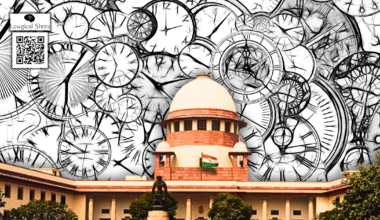Stray dogs controversy is not unheard of by any, be it dog lovers or those who fear the paws. This suo motu reaction and proceedings by the Supreme Court on Stray Dogs were ignited by news reports. The Apex Court made headlines in this matter with the previous order of relocation. Through the November 7 Stray Dog Order, Supreme Court expanded the previous order from streets to several institutions including schools, hospitals, bus stands and railway stations, etc. The recent directions of Supreme Court on stray dogs are divided into 3 parts and each part is targeted towards a specific authority.
Whether essential implementation takes place or not, there is a lot of work for sure. Find out what’s there for you or your peers.
Supreme Court Order on Stray Dogs (Nov 7, 2025)
SC order on Stray Dogs – Part 1
This part of the recent Supreme Court order on stray dogs was all about compliance affidavits filed by the States and Union Territories as per earlier directions on relocation of stray dogs. Additionally, it also contains the summary report of such affidavits as prepared by the Amicus Curiae Gaurav Agrawal.
The report, as pointed out by the Apex Court, highlighted “grave deficiencies and shortcomings” in information furnished by some States and UTs. In return, the Amicus came up with constructive suggestions and recommendations which may help ensure effective and uniform implementation of Supreme Court order on stray dogs.
The Supreme Court took the Amicus report on record. It further sought the report to be read as part and parcel of SC stray dog order. The lapse highlighted by the Amicus report needs to be addressed by the particular States and UTs. The Apex Court warned that “Any lethargy in this regard shall be viewed seriously”.
Stray Dog Order – Part 2
This part of the SC order on stray dogs discusses the modification, application and implementation of Rajasthan High Court’s directions (Civil Writ Petition No. 14726 of 2025). If you have been on a highway and your vehicle could not even touch the permitted speed just because the road had animals coming and going, you are not alone.
The Supreme Court also expressed in this regard that: “It is a matter of grave and continuing public concern that accidents caused by cattle and other stray animals on public roads and highways have become alarmingly frequent across the country. Such incidents, often resulting in loss of human life, grievous injuries, and damage to property, are not isolated events but symptomatic of a larger failure on the part of the administrative authorities entrusted with public safety. The uncontrolled presence of cattle and stray animals on National Highways, National Expressways, and State Highways, constitutes a serious and avoidable threat, particularly during night-time or in high-speed zones.”
The Court took account of the preventable nature of such accidents that reflect upon administrative indifference and undermine the right to life and safety under Article 21 of the Constitution. It pointed towards the need for immediate action by the municipal authorities, road and transport departments, public works departments and highway authorities in this direction.
Supreme Court Directions on Stray Dogs (November 7 Order)
- The Apex Court reaffirmed Rajasthan High Court directions to a specific extent. It directed the municipal authorities, road and transport department/Public Works Department of all the States and Union Territories and the National Highways Authority of India (NHAI) to ensure removal of all cattle and other stray animals from the State Highways, National Highways, and National Expressways within their jurisdictions.
- The concerned authorities to undertake a joint, coordinated drive to identify stretches of highways and expressways where stray cattle or animals are frequently found. Thereafter, they need to immediately remove and relocate the animals to designated shelters or Gaushalas/cattle pounds. The authorities also need to ensure that the animals be provided with all necessary food, water, and veterinary care as required under the Prevention of Cruelty to Animals Act, 1960 and the Animal Birth Control (Dogs) Rules, 2023.
- Authorities to constitute dedicated highway patrol teams and/or assign existing road-safety units for continuous surveillance and immediate response to reports of stray cattle or other animals obstructing the roadways. The patrol teams are further required to function on a 24×7 basis in coordination with local police stations, veterinary officers, and municipal authorities/Panchayati Raj institutions.
- Display helpline numbers on all National Highways, State Highways, and National Expressways at regular intervals. This is to enable commuters to promptly report the presence of stray animals or accidents caused. The helplines to be linked to control rooms of local police, National Highways Authority of India, and district administration for real-time redressal and monitoring.
- Chief Secretaries of all States and Union Territories, teamed up with the NHAI Chairperson to ensure strict enforcement of these directions through appropriate administrative orders and field-level monitoring. To officers concerned to be personally liable for lapses or recurring incidents in their jurisdiction.
- The directions under SC order on stray dogs dated November 7, 2025 to be uniformly implemented across India. The Chief Secretaries of all States and Union Territories, NHAI Chairperson and Union Ministry of Road Transport and Highways to file status-cum-compliance affidavits within 8 weeks indicating the mechanism, details of patrol teams, and helpline operational status for removal of stray animals.
Supreme Court on Stray Dogs – Part 3
The Supreme Court of India on November 7, 2025 issued further directions. These pertain to institutional areas, including educational establishments, hospitals, sports complexes, and other public areas. The specific areas are highlighted for continuation of incidents of dog-bite attacks with alarming frequency.
The Court pointed towards the disturbing increase in dog-bite incidents within the premises of educational institutions, hospitals, sports complexes, bus stands/depots (including Inter-State Bus Terminals) and railway stations as covered by various news reports and media accounts. The Court expressed distress that “The recurrence of such incidents, particularly within institutional spaces meant for learning, healing, and recreation, reflects not only administrative apathy but also a systemic failure to secure these premises from preventable hazards. The situation calls for immediate judicial intervention to safeguard the fundamental right to life and safety of citizens, especially children, patients, and sportspersons, under Article 21 of the Constitution of India.” The Court questioned India’s statistics of rabies related mortality despite significant advances in public health.
Looking at the Prevention of Cruelty to Animals Act, 1960, Animal Birth Control Rules, 2001, Capture-Sterilize-VaccinateRelease (CSVR) model, etc., the Court found their implementation ineffective. The Supreme Court also took note of news report about foreign nationals visiting India are falling prey to unprovoked stray dog attacks, reflecting a global perspective.
Reasons for Increasing Dog Bite Incidents
First, the part 3 of Supreme Court order on stray dogs first highlights the various incidents of dog bites in educational institutions, hospitals, railway stations, etc. Thereafter, the Court summed up the following reasons for such incidents:
- Uncontrolled reproduction of stray dogs owing to inadequate implementation of sterilisation programmes;
- Improper disposal of food waste in and around public institutions;
- Absence of effective perimeter management and institutional coordination with municipal authorities; and
- Lack of widespread public awareness regarding preventive conduct and post dog-bite medical procedures.
The Apex Court was concerned that “The menace of dog bites, particularly in public and private institutions that serve as spaces of learning, healing and recreation, thus constitutes not merely a public-health challenge but a matter of human safety concern.” The obligation upon State and its instrumentalities was recalled by the Supreme Court. It reflected upon their duty to protect citizens including children, elderly people and patients against preventable injury or disease within public premises.
Directions for Safety in Public Institutions
In its multi-faceted order on stray dogs, the Supreme Court of India issued the following directions to prevent dog-bite incidents in public institutions:
- States and UTs to identify all Government and private educational institutions, hospitals, public sports complexes or stadia, bus stands/depots (including Inter-State Bus Terminals) and railway stations situated within their territorial limits. This has to be done within 2 weeks through their respective local/ municipal authorities.
- The administrative heads of these institutions to ensure secure premises with adequate fencing, boundary walls, gates and such other structural or administrative measures to prevent ingress of stray dogs. This has to be done under the overall supervision of the District Magistrate within 8 weeks.
- Management of these institutions to designate a Nodal Officer. He/She is to be responsible for upkeep and cleanliness of the premises while ensuring that stray dogs do not enter or inhabit the campus. The details of Nodal Officer to be prominently displayed at the institution entrance and notified to the jurisdictional municipal body/authority.
- Local municipalities and panchayats to carry out regular inspections (at least 1 every 3 months) of such premises to ensure no stray dog habitats exist within or in immediate vicinity.
- Jurisdictional municipal body/authority responsible for removal of every stray dog found within the institutional premises. They may shift such animals to designated shelter, after due sterilisation and vaccination.The stray dogs so picked up shall not be released back to the same location from which they were picked up.
- All Government and private hospitals to maintain a mandatory stock of anti-rabies vaccines and immunoglobulin at all times.
- Every educational institution to be directed by the Education Ministry to conduct awareness sessions for students and staff on preventive behaviour around animals, first-aid in case of bites, and immediate reporting protocols.
- Management of stadiums and sports complexes to ensure deployment of security or ground-keeping personnel particularly tasked with 24*7 vigilance against the entry or habitation of stray dogs.
- Railway authorities for railway stations and State transport corporations and municipal authorities for bus stands, depots and inter-state bus terminals to ensure effective security and maintenance of public-transport premises/facilities. This is to prevent the habitation or movement of stray dogs within their premises. They are further tasked with implementation of waste-management systems to eliminate food sources that attract animals. They are required to conduct regular inspections to detect and address the presence of stray dogs.
- Animal Welfare Board of India to issue detailed SOPs for prevention of dog bites and management of stray dogs in institutional premises within 4 weeks. Such SOPs need to be uniformly adopted across all States and Union Territories.
These directions are not a substitute but an addition to Supreme Court order on stray dogs passed on August 22, 2025.
The Chief Secretaries of all States and Union Territories are required to submit compliance report within 8 weeks which reflects:
- Steps taken to secure institutional premises as specified in the SC order on stray dogs dated November 7, 2025.
- Mechanism placed for regular oversight inspection, coordination and reporting with municipal authorities/Panchayati Raj institutions.
- Availability of anti-rabies vaccines and immunoglobulin in all Government medical facilities.
The Union Government is also tasked to ensure the implementations of Supreme Court directions regarding institutions falling under its administrative or supervisory control. Other authorities tasked with filing reports are the Ministry of Health and Family Welfare and Animal Welfare Board of India.
The Supreme Court has made it clear that the above directions need to be taken seriously by all the authorities concerned. In case of contrary, there may be consequences like penalties, or even suo motu contempt proceedings. The next hearing of the Supreme Court in stray dogs matter is listed on January 13, 2026.








